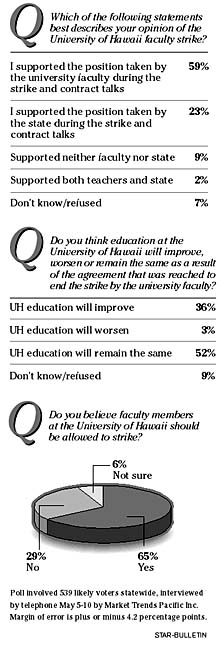

Strikers felt The hot lunches, rain ponchos, honking car horns and thumbs up were signs to striking teachers and professors that the community was behind them during their walkouts last month.
wide support
A Star-Bulletin/KITV-4
By Crystal Kua
survey shows 59%
backed HSTA, UHPA
Star-Bulletin"That's how the teachers were gauging the public support," Hawaii State Teachers Association President Karen Ginoza said.
About two-thirds of those polled said they believe that members of the HSTA and the University of Hawaii Professional Assmebly should be allowed to strike.
More than half of those surveyed - or 59 percent - said that they supported the positions taken by the teachers and professors unions during the strike. About one-fourth said they supported the state's position.

The poll also showed that while more than one-third of those interviewed think the new contracts that settled the strikes will bring an improved education system, the majority believe that public education in Hawaii will not change.The poll was taken among 539 likely voters who were interviewed by telephone May 5-10 by Market Trends Pacific Inc. for the Honolulu Star-Bulletin and KITV-4 News. It has a margin of error of plus or minus 4.22 percentage points.
Both the HSTA and the University of Hawaii Professional Assembly went on strike April 5 after contract talks failed. But from the get-go, public opinion appeared to side with striking teachers and professors.
UHPA Executive Director J.N. Musto said that a survey taken by the union before and during the strike confirmed the public support - albeit at higher percentages than the media poll.
That also meant, Musto said, that the union did a good job in getting its message across that the unions were asking for reasonable settlements.
"I think the basic bottom-line fact is that the public understood the issues," Musto said. "Our methods of communication were effective."
As a result, the public wasn't sour on the unions having the right to strike.
For example, 65 percent of those interviewed favored allowing UH faculty members to strike, 29 percent said they should not be allowed to walk off the job and 6 percent said they were not sure.
Teachers had even higher percentage of support with 68 percent believing they should be allowed to strike, 27 percent saying no and 6 percent indicating they were not sure.
"The strength of teachers was really amazing," Ginoza said. "The public support kept their spirits up."

Ginoza said she saw firsthand how the public supported teachers, dropping by hot lunches and snacks, cars honking their horns and neighborhood residents opening their homes and bathrooms."We went through the rain and the wind. One company gave ponchos," Ginoza said. "It was the little things that people did."
Having teachers and professors striking at the same time apparently also turned out to be effective.
"It was effective in the public sense in focusing it on education," Musto said. "Is this or is this not going to be a priority?"
But a little more than 50 percent of those surveyed said they believe that Hawaii's public education system will not change with the new contracts.
"I think that (they) are probably right," Musto said. "We stopped the bleeding, and we are attending to some of the wounded. ... This is a settlement in the face of the fight."
Ginoza said that the public heard mainly about the raises and not about the underlying issues in the contract that the union believes will strengthen public education through improving teacher quality.
"I think when the final settlement was reached, people focused on the numbers. They did not focus on the overall goal," Ginoza said.
The salary schedule in the new contract will help to attract and retain teachers, Ginoza said, issues that were central to the HSTA's message.
But the contract also covers professional development, peer assistance and national teacher certification.
"All of these things will help to enhance the profession, making teaching a true profession," Ginoza said.